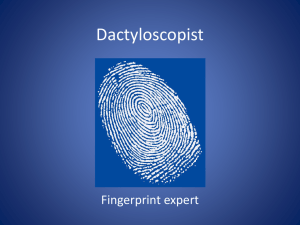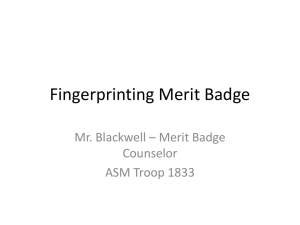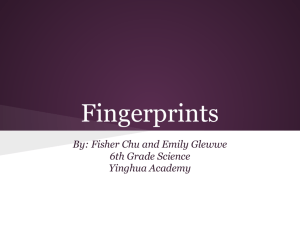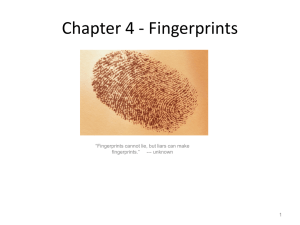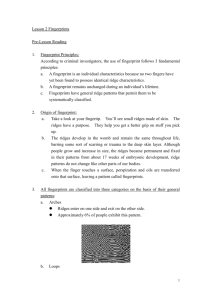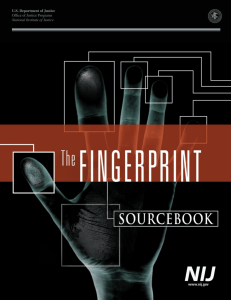1. Who published the first book on the science of fingerprinting
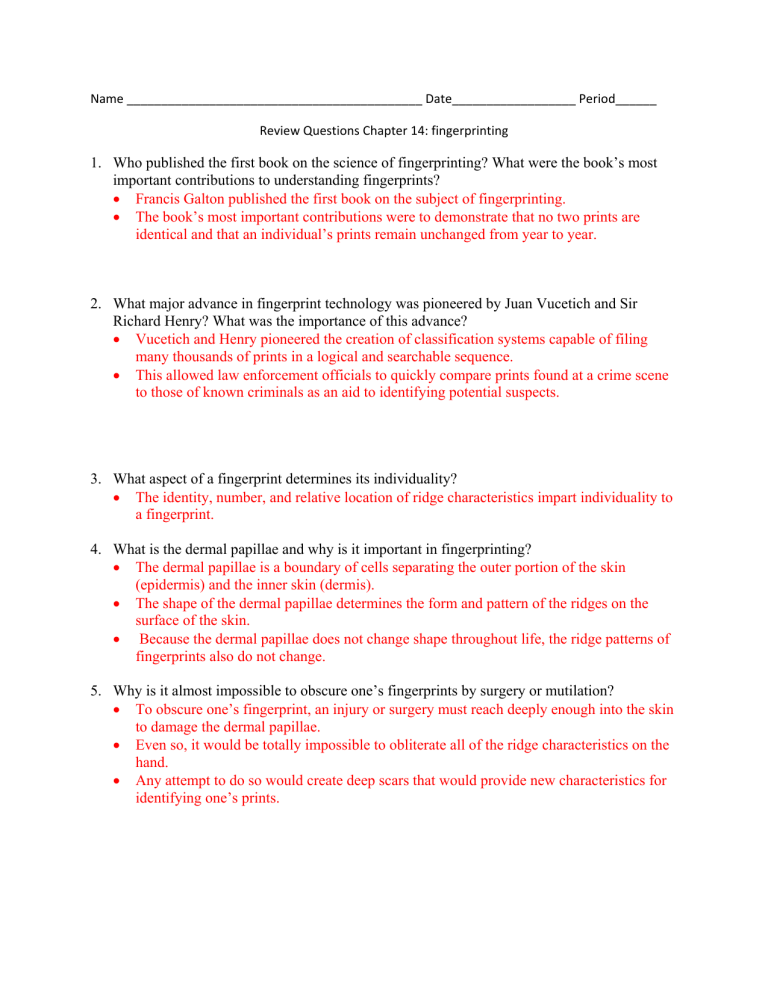
Name ___________________________________________ Date__________________ Period______
Review Questions Chapter 14: fingerprinting
1.
Who published the first book on the science of fingerprinting? What were the book’s most important contributions to understanding fingerprints?
Francis Galton published the first book on the subject of fingerprinting.
The book’s most important contributions were to demonstrate that no two prints are identical and that an individual’s prints remain unchanged from year to year.
2.
What major advance in fingerprint technology was pioneered by Juan Vucetich and Sir
Richard Henry? What was the importance of this advance?
Vucetich and Henry pioneered the creation of classification systems capable of filing many thousands of prints in a logical and searchable sequence.
This allowed law enforcement officials to quickly compare prints found at a crime scene to those of known criminals as an aid to identifying potential suspects.
3.
What aspect of a fingerprint determines its individuality?
The identity, number, and relative location of ridge characteristics impart individuality to a fingerprint.
4.
What is the dermal papillae and why is it important in fingerprinting?
The dermal papillae is a boundary of cells separating the outer portion of the skin
(epidermis) and the inner skin (dermis).
The shape of the dermal papillae determines the form and pattern of the ridges on the surface of the skin.
Because the dermal papillae does not change shape throughout life, the ridge patterns of fingerprints also do not change.
5.
Why is it almost impossible to obscure one’s fingerprints by surgery or mutilation?
To obscure one’s fingerprint, an injury or surgery must reach deeply enough into the skin to damage the dermal papillae.
Even so, it would be totally impossible to obliterate all of the ridge characteristics on the hand.
Any attempt to do so would create deep scars that would provide new characteristics for identifying one’s prints.
6.
Describe each of the three classes of fingerprints. Which class is the most common in the population? Which is least common?
The three classes of fingerprints are loops, whorls, and arches.
Loops are characterized by ridge lines that enter from one side of the pattern and curve around to exit from the same side of the pattern.
Whorls include ridge patterns that are generally rounded or circular in shape and have two deltas.
Arches are characterized by ridge lines that enter the print from one side and flow out the other side.
Loops are most common; arches are least common.
7.
What aspect of a fingerprint forms the basis for primary classification under the FBI system?
What is the main drawback of the FBI system?
The presence or absence of the whorl pattern is the basis for determining the primary classification in the FBI system.
The main drawback of the FBI system is that it is useful only when a full set of fingerprints is available.
8.
Briefly describe how the Automated Fingerprint Identification System (AFIS) creates a fingerprint image. What characteristics of the fingerprint does the AFIS record for comparison?
AFIS scans fingerprints and converts them into digital images that contain data on the relative location and orientation of ridge characteristics.
The system records the points where ridges terminate, the points where they branch into two ridges, and the relative position and orientation of each ridge characteristic.
9.
What is the final step in fingerprint identification? Why is this step necessary if a computerized database of fingerprints is available to the forensic scientist?
The final step in fingerprint identification is always visual comparison of the prints in question by a trained examiner.
A computer database can only produce a list of prints that are similar to the print in question; it cannot make a positive identification.
10.
List and describe the three types of fingerprints that may be found at a crime scene.
Visible prints are made when a finger deposits a visible material such as ink, dirt, or blood onto a surface.
Plastic prints are ridge impressions left on a soft material such as putty, wax, soap, or dust.
Latent or invisible prints are impressions caused by the transfer of body perspiration or oils present on finger ridges to the surface of an object.
11.
List two types of specialized fingerprint powders and name one advantage each has over traditional fingerprint powder.
Two specialized fingerprint powders are magnetic-sensitive powder and fluorescent powder.
Using magnetic-sensitive powder offers less chance that the print will be destroyed or damaged because the powder is spread using a magnetic brush that has no bristles to come in contact with the surface containing the print.
Fluorescent powders reveal a vivid image of a print under ultraviolet light. When the developing print is photographed under UV light, the color of the surface will not obscure the print.
12.
that is the most commonly used chemical method to visualize latent fingerprints on porous materials? If this method is unsuccessful, what other technique typically is used?
The ninhydrin method is most commonly used to visualize latent fingerprints onporous materials.
If the ninhydrin method fails, the Physical Developer technique typically is used.
13.
What phenomenon underlies many of the new chemical techniques used to visualize latent fingerprints? Why is this phenomenon so valuable in fingerprint visualization?
The phenomenon of fluorescence serves as the underlying principle of many of the new chemical techniques used to visualize latent fingerprints. Substances that emit light or fluoresce are more readily seen either with the naked eye or through photography as compared to non-light-emitting materials.
Thus, techniques based on fluorescence permit better visualization of all prints and allow the visualization of faint prints that other methods may fail to visualize.
14.
When should a fingerprint be “lifted” from a crime scene? Describe how to lift and preserve a fingerprint using adhesive tape.
A print should be “lifted” from a crime scene when it is on a large, immovable object.
One method of lifting is to dust the print with fingerprint powder, then cover the print with adhesive tape. When the tape is pulled up, the powder is transferred to the tape.
Then the tape is placed on a card that provides a good background contrast with the powder.
15.
What is digital imaging and how is it used in fingerprint analysis? What is the greatest limitation to digital imaging?
Digital imaging is a process through which a picture is converted into a series of square electronic dots known as pixels. It is used to compare fingerprints and to enhance poor fingerprint images.
The main limitation of digital imaging is that it is only as useful as the images it has to work with. If the images are poor or incomplete, enhancement procedures will not work.


